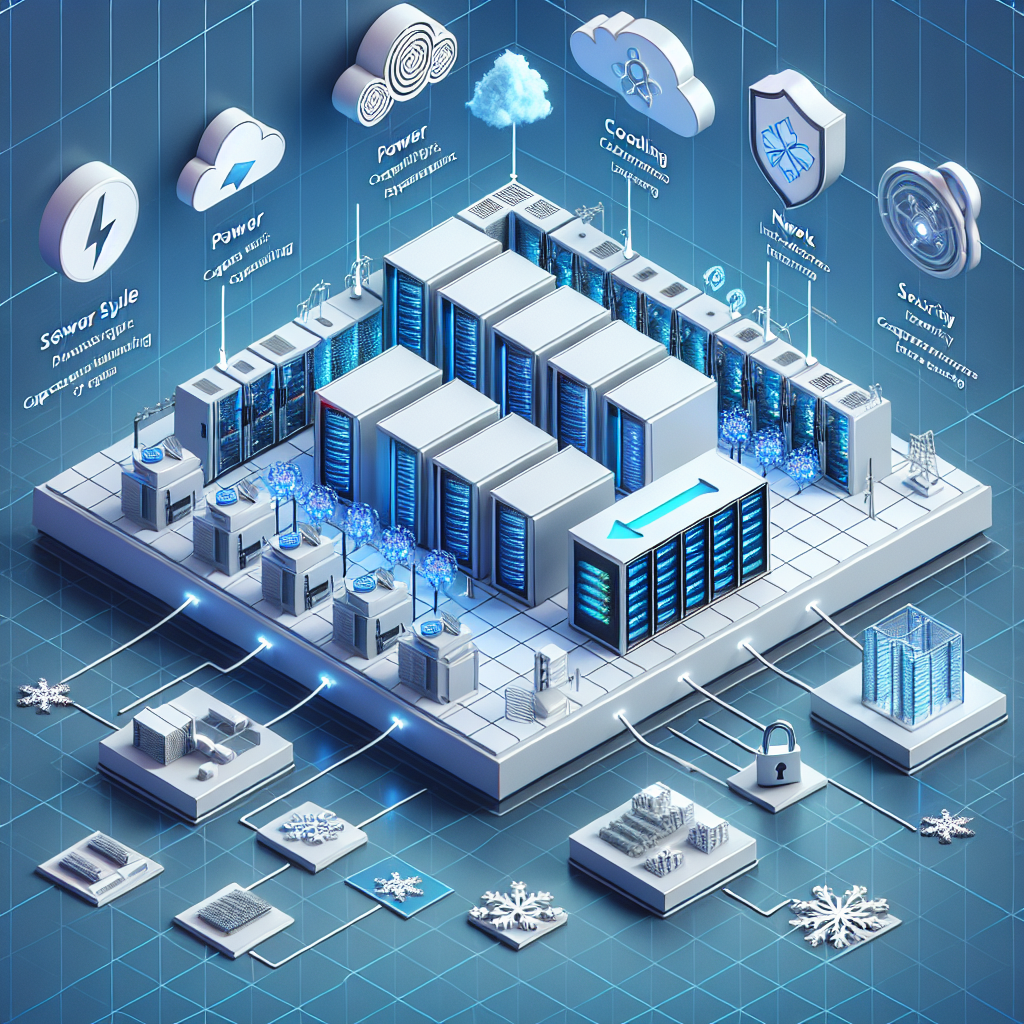Your cart is currently empty!
Tag: Successful

Implementing a Successful Data Center Audit Program: Strategies and Considerations
Implementing a Successful Data Center Audit Program: Strategies and ConsiderationsIn today’s digital age, data centers play a crucial role in storing and managing vast amounts of data for businesses of all sizes. With the increasing reliance on data centers, it is essential for organizations to regularly audit and assess the performance and security of their data center facilities. Implementing a successful data center audit program can help organizations identify potential risks, ensure compliance with industry regulations, and optimize the efficiency of their data center operations.
Here are some strategies and considerations for implementing a successful data center audit program:
1. Define the scope and objectives of the audit program: Before conducting an audit, it is important to clearly define the scope and objectives of the audit program. This includes identifying the key areas to be assessed, such as physical security, network infrastructure, power and cooling systems, and data backup and recovery processes. Establishing clear objectives will help guide the audit process and ensure that all relevant aspects of the data center facility are thoroughly evaluated.
2. Select a qualified audit team: To ensure the success of the audit program, it is essential to assemble a qualified audit team with the necessary expertise and experience in data center operations and security. The audit team should include professionals with knowledge of industry best practices, regulatory requirements, and emerging trends in data center technology. By selecting a qualified audit team, organizations can ensure that the audit process is conducted effectively and accurately.
3. Conduct a comprehensive risk assessment: Before conducting the audit, it is important to conduct a comprehensive risk assessment to identify potential vulnerabilities and weaknesses in the data center facility. This includes assessing physical security measures, environmental controls, network security protocols, and data protection mechanisms. By identifying potential risks and vulnerabilities, organizations can prioritize areas for improvement and develop strategies to mitigate any potential threats to the data center facility.
4. Implement industry best practices and standards: To ensure the effectiveness of the audit program, organizations should implement industry best practices and standards for data center operations and security. This includes adhering to regulatory requirements, such as the ISO 27001 standard for information security management, and following guidelines from organizations like the Uptime Institute and the Data Center Alliance. By implementing industry best practices and standards, organizations can demonstrate their commitment to maintaining a secure and efficient data center facility.
5. Monitor and track audit findings: Throughout the audit process, it is important to monitor and track audit findings to ensure that identified issues are addressed in a timely manner. This includes documenting audit results, tracking remediation efforts, and conducting follow-up audits to verify the effectiveness of corrective actions. By monitoring and tracking audit findings, organizations can identify trends and patterns in data center performance and security, and make informed decisions to improve the overall effectiveness of their data center operations.
In conclusion, implementing a successful data center audit program requires careful planning, qualified personnel, and adherence to industry best practices and standards. By defining the scope and objectives of the audit program, selecting a qualified audit team, conducting a comprehensive risk assessment, implementing industry best practices and standards, and monitoring audit findings, organizations can ensure the security, efficiency, and compliance of their data center facilities. By following these strategies and considerations, organizations can establish a robust audit program that helps them identify and address potential risks, optimize data center operations, and maintain the integrity of their data assets.

Strategies for Successful Vendor Management in Data Centers
Data centers are essential for housing and managing the vast amount of data that organizations generate and rely on for their operations. A key aspect of operating a successful data center is effective vendor management. Vendors play a crucial role in providing equipment, services, and support that are critical for the smooth functioning of a data center. Here are some strategies for successful vendor management in data centers:1. Establish clear expectations: It is important to clearly define the roles and responsibilities of each vendor to ensure that they understand what is expected of them. This includes specifying the scope of work, deliverables, timelines, and performance metrics. By setting clear expectations from the outset, you can avoid misunderstandings and ensure that vendors are accountable for their performance.
2. Develop strong relationships: Building strong relationships with vendors is essential for successful vendor management. Regular communication, feedback, and collaboration are key to fostering a positive and productive relationship. By maintaining open lines of communication and working closely with vendors, you can address issues proactively and ensure that they are aligned with your goals and objectives.
3. Conduct regular performance reviews: It is important to regularly evaluate the performance of vendors to ensure that they are meeting expectations and delivering value. Conducting performance reviews allows you to identify areas for improvement, address any issues or concerns, and recognize vendors for their achievements. By monitoring vendor performance on an ongoing basis, you can make informed decisions about whether to continue or adjust your relationship with them.
4. Monitor vendor compliance: Data centers are subject to various regulations and standards, such as security and compliance requirements. It is important to ensure that vendors comply with these regulations and standards to protect the security and integrity of your data center. Regular audits and assessments can help you verify vendor compliance and address any non-compliance issues in a timely manner.
5. Manage vendor contracts effectively: Vendor contracts should clearly outline the terms and conditions of the agreement, including pricing, deliverables, service levels, and termination clauses. It is important to review and negotiate contracts carefully to ensure that they are fair and favorable to your organization. Regularly monitor contract performance and renewal dates to avoid any disruptions or issues with vendors.
In conclusion, successful vendor management is crucial for the efficient operation of data centers. By establishing clear expectations, building strong relationships, conducting regular performance reviews, monitoring vendor compliance, and managing vendor contracts effectively, organizations can ensure that their vendors contribute to the success of their data center operations. By following these strategies, organizations can maximize the value they receive from their vendors and maintain a high level of performance and reliability in their data centers.

Key Considerations for Successful Data Center Capacity Planning
Data centers are the backbone of any organization’s IT infrastructure, serving as the hub for storing, processing, and managing data. With the increasing reliance on digital technologies and the exponential growth of data, proper capacity planning for data centers has become essential to ensure optimal performance and efficiency.Successful data center capacity planning requires careful consideration of various factors to meet the organization’s current and future needs. Here are some key considerations to keep in mind when planning for data center capacity:
1. Understand your current and future needs: The first step in capacity planning is to assess your organization’s current data center requirements and anticipate future growth. Consider factors such as the volume of data being generated, the number of users accessing the system, and the types of applications running on the infrastructure.
2. Evaluate existing infrastructure: Before planning for additional capacity, it’s important to evaluate the efficiency of your existing data center infrastructure. Assess the utilization rates of servers, storage, and networking equipment to identify any bottlenecks or areas of improvement.
3. Consider scalability: When planning for data center capacity, it’s crucial to consider scalability. Choose infrastructure solutions that can easily scale up or down based on your organization’s changing needs. This will help avoid over-provisioning or under-provisioning resources, ensuring optimal performance and cost-efficiency.
4. Plan for redundancy: Redundancy is essential for ensuring high availability and minimizing the risk of downtime. Implementing redundant power supplies, cooling systems, and network connections can help mitigate the impact of hardware failures or maintenance activities.
5. Embrace virtualization and cloud technologies: Virtualization and cloud technologies can help optimize data center capacity by consolidating workloads and enabling flexible resource allocation. Consider adopting these technologies to maximize efficiency and reduce hardware and operational costs.
6. Implement monitoring and management tools: To effectively manage data center capacity, invest in monitoring and management tools that provide real-time visibility into resource utilization, performance metrics, and potential bottlenecks. These tools can help identify issues proactively and make informed decisions about capacity planning.
7. Plan for future growth: Data centers are not static environments – they need to evolve to accommodate the organization’s growing data and workload requirements. When planning for capacity, consider future growth projections and build in flexibility to scale resources as needed.
In conclusion, successful data center capacity planning requires a holistic approach that considers current and future needs, evaluates existing infrastructure, embraces scalability and redundancy, leverages virtualization and cloud technologies, and implements monitoring and management tools. By carefully considering these key factors, organizations can ensure their data centers are equipped to meet the demands of today’s digital world and support business growth and innovation.

Best Practices for Successful Data Center Change Management
In today’s fast-paced and ever-evolving technology landscape, data centers play a crucial role in the success of businesses. As organizations continue to rely heavily on their data centers to store, process, and manage their critical data, it is essential to have effective change management practices in place to ensure the smooth and efficient operation of these facilities.Data center change management refers to the process of planning, implementing, and controlling changes to the infrastructure, systems, and processes within a data center environment. It is essential for ensuring that any modifications or updates made to the data center do not disrupt the services or impact the overall performance of the facility.
To help organizations ensure the success of their data center change management initiatives, here are some best practices to follow:
1. Establish a Change Management Policy: The first step in successful data center change management is to establish a formal change management policy that outlines the procedures and guidelines for making changes to the data center environment. This policy should define the roles and responsibilities of all stakeholders involved in the change management process and provide a clear framework for implementing and tracking changes.
2. Conduct a Comprehensive Impact Analysis: Before making any changes to the data center environment, it is crucial to conduct a thorough impact analysis to assess the potential risks and implications of the proposed changes. This analysis should consider factors such as system dependencies, potential downtime, and the impact on service levels to ensure that any changes are implemented in a controlled and systematic manner.
3. Implement a Change Control Process: A formal change control process should be implemented to manage and track all changes made to the data center environment. This process should include procedures for requesting, reviewing, approving, and implementing changes, as well as mechanisms for documenting and communicating the status of changes throughout the organization.
4. Test Changes in a Controlled Environment: Before implementing any changes to the production environment, it is essential to test them in a controlled environment to ensure that they do not have any adverse effects on the data center operations. Testing should include validation of the changes against predefined criteria and the simulation of potential failure scenarios to identify any potential issues before they occur in the live environment.
5. Communicate Changes Effectively: Effective communication is key to successful data center change management. All stakeholders, including IT teams, business users, and management, should be kept informed of any planned changes, their potential impact, and the expected timeline for implementation. Clear and timely communication helps to minimize misunderstandings and ensures that all parties are aware of the changes being made.
By following these best practices for successful data center change management, organizations can ensure that any modifications or updates to their data center environment are implemented smoothly and efficiently, minimizing the risk of disruption and maintaining the stability and performance of their critical infrastructure.

Case Studies: Successful Root Cause Analysis in Data Center Environments
In the fast-paced world of data centers, identifying and addressing root causes of issues is crucial to maintaining optimal performance and minimizing downtime. Root cause analysis (RCA) is a systematic process that helps organizations identify the underlying cause of problems and develop effective solutions to prevent them from recurring. In this article, we will explore some successful case studies of root cause analysis in data center environments.Case Study 1: Server Performance Issues
A large financial institution was experiencing frequent slowdowns and performance issues with their servers, leading to disruptions in their operations. After conducting a thorough root cause analysis, the IT team discovered that the servers were being overloaded due to inadequate cooling and ventilation systems in the data center. By implementing a comprehensive cooling solution and optimizing server configurations, the organization was able to significantly improve performance and prevent future issues.
Case Study 2: Network Outages
A global technology company was facing frequent network outages in their data center, causing disruptions in service delivery and impacting customer satisfaction. Through a detailed root cause analysis, the IT team identified that the outages were caused by faulty network equipment and outdated infrastructure. By replacing the faulty equipment and upgrading their network infrastructure, the organization was able to eliminate network outages and improve reliability.
Case Study 3: Storage Capacity Constraints
A growing e-commerce company was struggling with storage capacity constraints in their data center, leading to delays in data processing and storage management. After conducting a root cause analysis, the IT team discovered that the storage constraints were due to inefficient data management practices and lack of scalable storage solutions. By implementing automated data management tools and investing in scalable storage solutions, the organization was able to optimize storage capacity and improve data processing efficiency.
In conclusion, root cause analysis is a critical process for identifying and addressing issues in data center environments. By conducting thorough investigations and implementing effective solutions, organizations can improve performance, reduce downtime, and enhance the overall reliability of their data centers. The case studies highlighted in this article demonstrate the importance of root cause analysis in successfully addressing challenges in data center environments.

Implementing a Successful Data Center Change Management Plan
Implementing a Successful Data Center Change Management PlanChange is inevitable in any organization, especially when it comes to managing a data center. With the rapid pace of technological advancements and business needs, data centers must constantly evolve to meet the demands of the digital age. However, managing these changes can be a daunting task, as even a small misstep can result in system downtime, data loss, and potential security breaches.
This is where a well-thought-out data center change management plan comes into play. By implementing a structured approach to managing changes in the data center, organizations can minimize risks, improve operational efficiency, and ensure seamless transitions. Below are some key steps to help organizations implement a successful data center change management plan.
1. Establish a Change Management Team: The first step in implementing a successful data center change management plan is to establish a dedicated change management team. This team should consist of key stakeholders from various departments, including IT, operations, and security. The team should also include a change manager who will oversee the entire change management process, from planning to implementation.
2. Define Change Management Processes: Once the change management team is in place, the next step is to define the change management processes. This includes creating a standardized process for requesting, reviewing, approving, and implementing changes in the data center. It is important to establish clear guidelines and procedures for handling different types of changes, including hardware upgrades, software updates, and configuration modifications.
3. Implement Change Control Mechanisms: To ensure that changes are implemented in a controlled and systematic manner, organizations should implement change control mechanisms. This includes using change management tools and software to track and monitor changes, as well as establishing change control boards to review and approve proposed changes. By enforcing strict change control mechanisms, organizations can minimize the risk of unauthorized changes and ensure compliance with industry regulations.
4. Conduct Impact Assessments: Before implementing any changes in the data center, organizations should conduct thorough impact assessments to evaluate the potential risks and implications of the proposed changes. This includes assessing the impact on system performance, data integrity, and security, as well as identifying potential dependencies and dependencies. By conducting comprehensive impact assessments, organizations can proactively address potential issues and mitigate risks before they escalate.
5. Communicate Effectively: Communication is key when it comes to implementing a successful data center change management plan. Organizations should establish clear communication channels to keep stakeholders informed about upcoming changes, including IT staff, end users, and senior management. This includes providing regular updates on the status of changes, as well as communicating any potential impacts or disruptions to operations. By fostering open and transparent communication, organizations can build trust and collaboration among stakeholders and ensure a smooth transition during change implementations.
In conclusion, implementing a successful data center change management plan is essential for ensuring the stability and reliability of the data center environment. By following these key steps, organizations can minimize risks, improve operational efficiency, and ensure seamless transitions during change implementations. It is important for organizations to continuously evaluate and refine their change management processes to adapt to the evolving needs of the data center and ensure business continuity.

Key Steps for Successful Data Center Maintenance Planning
Data centers are essential for storing and managing critical business data. To ensure their smooth operation, regular maintenance is crucial. Without proper planning and execution, data centers can experience downtime, leading to loss of revenue and data integrity. Here are key steps for successful data center maintenance planning:1. Conduct a comprehensive assessment: Before creating a maintenance plan, it’s essential to assess the current state of your data center. This includes evaluating the condition of hardware, software, cooling systems, power supply, and security measures. Identify any potential issues or areas that require immediate attention.
2. Set maintenance goals and priorities: Once you have assessed the data center, establish clear maintenance goals and priorities. Determine what needs to be addressed first and create a timeline for completing maintenance tasks. Prioritize critical components that impact the overall performance and security of the data center.
3. Create a maintenance schedule: Develop a detailed maintenance schedule that outlines regular maintenance tasks, such as equipment inspections, software updates, and system backups. Assign specific tasks to designated team members and ensure they have the necessary tools and resources to complete them.
4. Implement preventive maintenance measures: To minimize the risk of unexpected downtime, incorporate preventive maintenance measures into your plan. This includes performing routine inspections, cleaning, and testing of equipment to identify potential issues before they escalate into major problems.
5. Conduct regular performance monitoring: Monitoring the performance of your data center is essential for identifying any issues or bottlenecks that may impact its operation. Use monitoring tools to track key performance indicators, such as server uptime, network bandwidth, and temperature levels, and address any anomalies promptly.
6. Document maintenance activities: Keep detailed records of all maintenance activities, including the date, time, and outcome of each task. This documentation will help track the progress of maintenance efforts, identify recurring issues, and provide valuable insights for future planning.
7. Review and adjust the maintenance plan: Regularly review the maintenance plan to ensure it remains effective and relevant. Update the plan as needed to accommodate changes in technology, business requirements, or regulatory compliance. Seek feedback from team members and stakeholders to improve the maintenance process.
By following these key steps for successful data center maintenance planning, you can ensure the optimal performance and reliability of your data center. A well-executed maintenance plan will help prevent downtime, minimize risks, and safeguard your critical business data. Remember that proactive maintenance is always more cost-effective than reactive fixes, so invest the time and resources needed to keep your data center running smoothly.

Top Strategies for Conducting a Successful Data Center Audit
In today’s digital age, data centers play a crucial role in storing and managing vast amounts of information for businesses of all sizes. However, ensuring the security and efficiency of data centers is a complex task that requires regular auditing. A data center audit is a comprehensive evaluation of the physical, technical, and operational aspects of a data center to identify any potential risks or weaknesses. To help organizations conduct a successful data center audit, here are some top strategies to consider:1. Define the scope and objectives: Before conducting a data center audit, it is essential to clearly define the scope and objectives of the audit. This includes identifying the specific areas of the data center that will be evaluated, as well as the goals and expectations of the audit process.
2. Conduct a risk assessment: A thorough risk assessment is a critical component of a successful data center audit. This involves identifying and evaluating potential risks and vulnerabilities in the data center’s physical infrastructure, network security, and operational processes.
3. Review documentation and policies: It is essential to review and analyze all relevant documentation, including data center policies, procedures, and service level agreements. This will help ensure that the data center is operating in compliance with industry standards and best practices.
4. Perform a physical inspection: A physical inspection of the data center facility is necessary to assess its overall condition and security measures. This includes evaluating the layout of the data center, the condition of equipment and infrastructure, and the implementation of security controls.
5. Assess network and data security: A key aspect of a data center audit is evaluating the network and data security measures in place. This includes assessing the effectiveness of firewalls, intrusion detection systems, encryption protocols, and access controls to protect sensitive data from cyber threats.
6. Test disaster recovery and business continuity plans: Disaster recovery and business continuity plans are essential for ensuring the resiliency of a data center in the event of a disruption or disaster. It is important to test these plans regularly to ensure they are effective and can be implemented efficiently.
7. Document findings and recommendations: Following the audit, it is crucial to document all findings and recommendations in a comprehensive report. This report should outline any areas of concern, potential risks, and recommended actions to address any issues identified during the audit.
By following these top strategies for conducting a successful data center audit, organizations can ensure the security, efficiency, and reliability of their data center operations. A thorough audit process can help identify and mitigate potential risks, improve operational performance, and enhance overall data center security and compliance.
